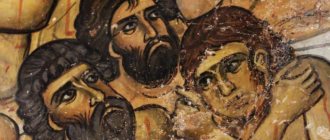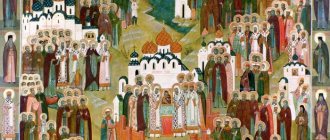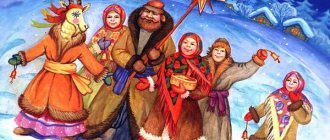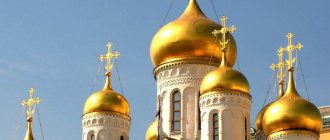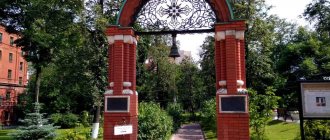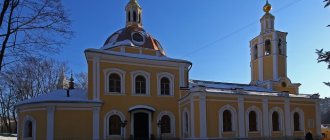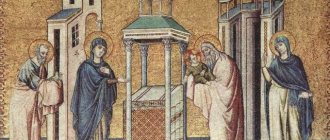Home › Holidays
| Date in 2022 | November 1, 2022, Tuesday |
| Church name: | Pentecost, All Souls' Day |
| Meaning: | The memory of the departed, holy people who died in the name of faith and truth is honored |
| Other names: | Halloween, All Souls' Day, Day of the Dead, All Saints' Week |
| Traditions: | Fortune telling, treats for the poor |
History of the holidayTraditions and ritualsSigns
All Saints' Day is celebrated in Orthodoxy on the Sunday following the Holy Trinity. Orthodox Christians and Catholics often have the same holidays, but with different faiths. But, like the Trinity, Saints Day is celebrated on different days every year. At the same time, for Catholics this holiday takes place on the same day in the fall: November 1st. On the eve of this holiday, Halloween takes place, which will soon be celebrated by believers.
All Saints' Day
Orthodoxy deeply honors those people who in earthly life have achieved wisdom, enlightenment, and sacred knowledge through the Gifts of the Holy Spirit. With their true service to God, constant prayers, asceticism, and asceticism, they not only earned recognition and respect during their lifetime, but even after leaving the world they are an example of faith, humility, and unconditional love.
In Russia, on All Saints' Day, they remember not only the canonized, but also all the unknown followers of the church who compared their lives with the commandments of the Lord and the laws of God.
History and traditions of All Saints' Day
The Christian Church has long honored people who dedicated their lives to serving God. The first were the apostles. They were close to Jesus during his earthly life, received sacred knowledge from him, and after the death of the Savior continued to preach the Gospel.
The next to be revered by the church were the holy martyrs and martyrs. They accepted torture and death in the name of the One God and did not spare their lives, preaching holy knowledge. Then the ministers of the church who during their lifetime were saints, ascetics, reverend monks, prophets, and defenders of “ancient piety” began to be canonized.
It is impossible to count all the people who became righteous martyrs in earthly life and accepted death for their faith. It is also impossible to take into account all those who selflessly promoted the teachings of Christ to the masses, prayed, indulged in asceticism, and in solitude for peace. Not everyone was glorified and canonized by the church, but before God they are God’s Saints, saints.
They began to celebrate and glorify all the saints a long time ago - at the end of the 4th and beginning of the 5th centuries. The sermon of John Chrysostom, the Archbishop of Constantinople and theologian, has survived to this day, in which he commemorates all the saints who suffered for the faith. The theologian says that he saw a large number of people from different tribes and peoples, speaking different languages, standing before the Lamb, and it was impossible to count them. Such a number of righteous people received God's blessing after leaving earthly life.
Those who became famous before God and the church were commemorated on different days. Christian theologian Ephraim the Syrian mentions the Feast of All Saints, which was celebrated on May 13th. The liturgical book - the Syriac Lectionary - speaks of the date of the celebration of the Saints - on the Friday following Easter. The practice of the Jerusalem Church of the 5th-7th centuries included the veneration and glorification of the holy martyrs and martyrs on January 22, and the apostles and saints who accepted their teaching on April 16.
The Studio Charter (Typikon), and then the Jerusalem Charter, determined the exact date of the holiday and placed it in the church calendar on the first Sunday after Trinity (Pentecost). Catholics celebrate this date on the first of November.
How Orthodox Christians Celebrate All Saints' Day
On this day in Rus' they celebrated the end of spring and the onset of summer. We had a lot of fun, since at this time the spring meat-eating season ends and before the Apostolic (Petrine) fast one could afford any food. Most often, celebrations and feasts took place in nature. In the evening, when it became dark, young people lit fires near ponds. They started games, walked around as mummers, joked about scaring people, and danced in circles.
The tradition has survived to this day of attending a church service, and then gathering with the whole family at home at a common set table, inviting relatives to your place, visiting the sick and lonely with treats, and giving alms.
When is All Saints' Day celebrated?
This holiday is a moving holiday and depends on the date of Easter. It is celebrated exactly eight weeks after the Holy Resurrection of Christ. In 2022 – June 19.
Divine service for the holiday of All Saints' Day
This holiday is a border holiday in the order of services established by the annual liturgical circle of the Orthodox Church. This means that the period when the chants of the Colored Triodion (three-song canons) were used during worship has ended and a new period has begun when the Octoechos (Osmoglasnik) is sung.
During the morning service of All Saints Day, the Sunday Gospels are read.
Thematically, 11 events were selected for this purpose, which tell about the appearance of the Lord Jesus after His miraculous Resurrection. The number 11 has a sacred meaning: this is the number of the apostles (not counting Judas Iscariot and Matthias, who was chosen later), the followers of the Savior.
At Vespers, three proverbs are read with Old Testament references to the glory of the saints. The next day - Monday - instead of the Acts of the Holy Apostles and the Gospel of John, the liturgy of the Epistle of the Apostle Paul to the Romans and the Gospel of Matthew is read. At the same time, the Apostolic Fast replaces the period when the consumption of fast food was allowed on all days of the week - the continuous (omnivorous) week after Pentecost.
The hymnography of the holiday uses high-flown epithets: “the beginnings of nature”, “patient-hearted”, “Divine cloud”, “beautiful luminaries”.
Troparion
A troparion is dedicated to the celebration with a request to the Lord for mercy for human souls.
Troparion to the Cathedral of All Saints, tone 4
And throughout the whole world Thy martyr,/ as with scarlet and visor,/ Thy Church is adorned with the blood,/ with them cries out to Thy Christ God:/ unto Thy people Thy bounties have come down,/ peace Grant to Thy habitation, // and to our souls great mercy.
Translation: With the blood of Your martyrs who suffered throughout the world, clothed as in purple and fine linen, through their lips Your Church cries out to You, O Christ God: “Send down Your mercies to Your people, grant peace to Your people and great mercy to our souls!”
Kontakion
The chant dedicated to the holiday glorifies the merits of the God-bearing martyrs.
Kontakion to the Synaxis of All Saints, tone 8
Like the firstfruits of nature, to the Planter of creation,/ the universe brings to You, Lord, God-bearing martyrs./ By those prayers in the deep world Thy Church, // Thy residence, has been preserved by the Mother of God by many more kindly
Translation: As the first fruits of nature, to the Planter of all creation, the universe brings, to You, O Lord, God-bearing martyrs. Through their prayers and the intercession of the Mother of God, preserve Your Church - Your people in deep peace, O Most Merciful One.
The appearance of the holiday
The emergence of a common church memory of all martyrs, or all saints, occurred in the Eastern part of the Roman Empire no later than the end or beginning of the century. In the sermon of St. John Chrysostom in memory of “all the saints who suffered throughout the world,” it is reported that this holiday is celebrated a week after the Feast of Pentecost [1]. It was this custom that eventually spread throughout the Orthodox Church.
In Syria of the same era, this holiday also existed, but was celebrated at a different time. Thus, among the hymns of St. Ephraim the Syrian there are indications of the celebration of the memory of all saints on May 13 [2], and the Syriac Lectionary of 411 indicates this memory on the Friday after Easter [3].
In the Georgian translation of the Jerusalem Lectionary, reflecting the practice of the 7th century, the memory of all martyrs is indicated on January 22, followed at the liturgy: troparion of the 4th tone “Rejoice, martyrs of the Lord,” reading (prokeimenon from Ps 115, Proverbs 29, 2-6 , Isa. 65, 13-18, Hebrews 12, 1-11, alleluia with a verse from Ps 88, John 15, 20-16. 5a), troparion of the 2nd tone for the washing of hands “The original institutions,” troparion 4 -th voice for the transfer of Gifts “Sacrifice for you.” In addition, April 16 in this monument is about without specifying the sequence [4].
In the Western lands of the Roman Empire, the celebration of May 13, mentioned by St. Ephraim the Syrian, was also known. It was on May 13, 609 or 610 that Pope Boniface IV consecrated the former Pantheon in Rome as a temple in the name of the Blessed Virgin Mary and all the martyrs, after which this event was celebrated in the Western Church. In the first half of the 8th century, Pope Gregory III consecrated one of the chapels of St. Peter's Basilica in the name of All Saints and established an annual commemoration of this event on November 1, and a century later, Pope Gregory IV officially approved the feast of All Saints in the Western Church on this day. On October 31, on the eve of the holiday, fasting was supposed [5].
All Saints Sunday
Orthodox churches honor all saints on the first Sunday (which is why this day is called “All Saints Week”) after the celebration of Pentecost or Trinity Day. This is symbolic because the Trinity marks the descent of the Holy Spirit on the apostles. And all the saints were awarded the same grace, because everyone is equal before God.
And the next Sunday - the second after Trinity - the Russian Orthodox Church dedicates to the “Sunday of all saints who have shone in the Russian land.” This day was established during difficult times for Holy Rus', in August 1918. In honor of this event, a house church was chosen at Petrograd University, which was illuminated in memory of Russian saints. It was headed by Archpriest Vladimir Konstantinovich Lozina-Lozinsky, who was killed by the Bolsheviks in 1937.
Vladimir Konstantinovich is canonized by the Orthodox Church as a holy martyr.
History of the Feast of Saint Eudoxia
I would like to pay attention to another interesting holiday of a saint, who was given a special day in the Orthodox calendar. March 14 is considered the day of St. Eudoxia. The name of this woman became associated with the patronage and greatness of earthly nature and with the awakening of the power of the earth.
According to legend, Evdokia was a very attractive and beautiful female representative; her income came from the most ancient profession in the world - pleasing men.
One day, the monk Herman converted the girl to Christianity. The woman took this difficult step, given her lifestyle, thanks to the fact that the Archangel Michael appeared to her, who helped her escape from Satan’s lair.
After accepting Christianity, Evdokia transferred all her wealth to Bishop Theodotus and went to a nunnery, which was located not far from Herman’s monastery. After some time, local authorities found out that treasures were hidden in the monastery, and they sent soldiers to search it. In the life of Evdokia it is written that the soldiers for three days could not get into the monastery, which was supported by divine forces. They were even attacked by a huge snake, which destroyed almost the entire squad. At the time of all these events, a vision came to Evdokia, the essence of which was that the girl must suffer for Christ. After this, she voluntarily gave herself into the hands of the local authorities, taking the Holy Gifts with her.
Seeing the girl, Governor Diogenes was struck by her beauty. Evdokia, who professed to be a Christian, agreed to suffer in the name of Christ. Afterwards she had to accept martyrdom - beheading with a sword.
Folk traditions on All Saints Sunday
This week in Rus' was called “Rusal”. All believers were given the opportunity to rest. In the Tambov province, in the evening or the next day (in the morning or in the afternoon), young people organized noisy games. Peasant boys put on canvas sheets or sackcloth and took refuge in the rye fields not far from the village. When the girls approached the crops, one of the young men began to crack his whip.
The girls shouted that they were mermaids and ran away. The mummers rushed in pursuit. Then the young women asked how flax would be produced, and the guys pointed to the size of the whip. The longer the whip, the larger the crops will be.
Young people in the Penza province prepared outfits in advance. They dressed up as different animals: goats, horses, pigs. They often used stilts and smeared their faces with soot. The mummers were surrounded by laughing girls and boys. The entire celebration was necessarily accompanied by playing the harmonica, balalaika, songs and dances, swinging on swings, and round dances. The general noise was joined by blows on the stove dampers and frying pans.
The holiday moved from one village to another. The mummers went to the houses of wealthy villagers and demanded treats and vodka. This is how we saw off the spring and greeted the hot summer - the flyover. Many rituals performed on this day personified dying and resurrection. In some provinces, funerals were held for the mermaid, Kostroma, and Chekhon. They dressed a straw effigy with old things, mourned it, and then drowned it in the river or tore it into small pieces and scattered it across the field.
In the evening, usually the older generation went home, and the young people walked until the morning, girls and boys swam in the river. They say that all these rituals were supposed to distract people from the Slavic Kupala, which falls on the day of the Solstice.
Old Believers and Edinoverie churches in honor of all saints
In honor of the popularly revered holiday, the following temples were illuminated:
- In the Kaluga province, in the city of Borovsk, the Church of All Saints was opened in 1890. It existed until 1928. The building has survived to this day, but now it houses the Arts Center.
- In 1862, the All Saints Monastery was founded in Moscow. It was closed under Soviet rule in 1922. The territory was annexed to. By 1934 the churches were destroyed. Only the building of one of them - Nikolskaya - has survived to this day, but it is used for offices.
- Another one, the All Saints Monastery for women, was opened at the end of the 19th century in the city of Shuya, which is located in the Ivanovo region. In 1930, all churches on its territory were closed. In 1931, the Assumption Cathedral was blown up. And by 1955, the rest of the buildings that once belonged to the monastery were destroyed.
Day of the Great Martyrs of Sebastia: history of origin
Another important Christian holiday is March 22, when Orthodox Christians celebrate the Day of Forty Saints. History says that the 40 Martyrs of Sebastia were one of the best squads in the army of the ancient Roman emperor, whose name was Licinius. He was a cruel pagan and was engaged in the persecution of Christian believers and all those who preached faith in God.
Forty great warriors refused to renounce the Christian faith. They died in terrible agony. Licinius ordered them to be taken to Lake Sebaste. During the night it was completely covered with ice. This seemed not enough to the emperor, and in order to make the death more painful, he ordered the bathhouse to be flooded on the shore. One of the warriors came out of the lake, unable to withstand the torture, but immediately fell dead. Then the warden, who was amazed by the courage of this squad, also went into the lake, saying: “I, too, am a Christian.” There were 40 of them again.

